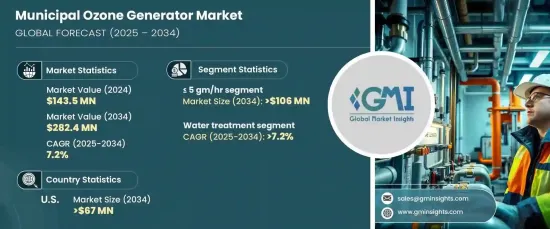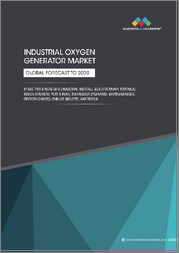
|
시장보고서
상품코드
1664858
도시 오존 발생기 시장 기회, 성장 촉진요인, 산업 동향 분석 및 예측(2025-2034년)Municipal Ozone Generator Market Opportunity, Growth Drivers, Industry Trend Analysis, and Forecast 2025 - 2034 |
||||||
세계의 도시 오존 발생기 시장은 2024년에 1억 4,350만 달러가 되고, 2025년부터 2034년에 걸쳐 7.2%의 연평균 복합 성장률(CAGR)로 견조하게 성장할 것으로 예측되고 있습니다.
이러한 첨단 시스템은 물 살균, 오염물질 분해, 악취 및 유해화학물질 제거를 위한 강력한 산화 특성을 활용하여 대규모 수처리 및 폐수 처리를 위한 오존 가스를 생성하도록 설계되었습니다. 이를 통해 도시 상수의 안전한 배급과 환경 친화적인 폐수 배출이 보장됩니다.

도시 오존 발생기의 채택이 증가하고 있는 주요 요인 중 하나는 환경의 지속가능성이 중요하다는 점입니다. 이러한 환경 친화적인 시스템은 유해한 잔류물을 남기지 않고 환경 보호에 대한 세계의 노력과 일치합니다. 게다가 의약품, 마이크로플라스틱, 퍼스널케어 제품의 잔류물 등의 새로운 오염물질을 수원으로부터 제거하는 과제가 높아지고 있는 것도 오존 발생기 수요를 크게 밀어 올리고 있습니다. 복잡한 오염물질을 분해하는 효과로 오존 발생기는 첨단 처리 솔루션을 요구하는 지자체에게 최선의 선택이 되었습니다.
| 시장 범위 | |
|---|---|
| 시작 연도 | 2024년 |
| 예측 연도 | 2025-2034년 |
| 시작 금액 | 1억 4,350만 달러 |
| 예측 금액 | 2억 8,240만 달러 |
| CAGR | 7.2% |
시장은 용량별로 분할되고 5g/h 이하 부문은 2034년까지 1억 600만 달러의 매출이 예상됩니다. 이 성장은 소규모 저수지의 처리, 국소적인 급수, 인프라가 제한된 지역의 보조 시스템에 최적인 콤팩트한 발전기 유닛에 대한 수요 증가로 인한 것이 큽니다. 이 단위는 비용 효과적이기 때문에 인구가 적은 지방 자치 단체와 예산에 제약이 있는 지방 자치 단체에 특히 매력적이며 보급에 박차를 가하고 있습니다.
용도별로, 수처리 분야는 2034년까지 연평균 복합 성장률(CAGR) 7.2%로 성장할 것으로 예측됩니다. 식수의 안전성과 폐수 배출을 둘러싼 규제의 강화가 오존 발생기 수요를 밀어 올리고 있습니다. 이 시스템은 부산물 생산을 최소화하면서 화학물질을 사용하지 않는 살균을 제공하여 환경 및 건강 위험을 줄입니다. 오염물질 제거에 대한 엄격한 지침을 충족하는 능력으로 오존 발생기는 최신 수처리에 필수적인 도구가 되었습니다.
미국에서는 지자체 오존 발생기 시장이 2034년까지 6,700만 달러를 창출할 것으로 예상됩니다. PFAS 및 마이크로플라스틱과 같은 새로운 오염물질을 다룰 필요성은 이러한 고효율 시스템에 대한 수요를 촉진하고 있습니다. 게다가 미국에서는 수도 인프라의 노후화가 현대화의 필요성을 높이고 있으며, 지자체는 운영 효율성을 향상시키는 솔루션을 요구하고 있습니다. 원격 모니터링 및 에너지 최적화와 같은 기능을 갖춘 오존 발생기는 수도 시스템을 업그레이드하는 신뢰할 수 있는 솔루션으로 인기가 높아지고 있습니다.
목차
제1장 조사 방법과 조사 범위
- 시장의 정의
- 기본 추정과 계산
- 예측 계산
- 1차 조사와 검증
- 1차 소스
- 데이터 마이닝 소스
- 시장 정의
제2장 주요 요약
제3장 업계 인사이트
- 업계 에코시스템
- 규제 상황
- 업계에 미치는 영향요인
- 성장 촉진요인
- 업계의 잠재적 리스크·과제
- 성장 가능성 분석
- Porter's Five Forces 분석
- 공급기업의 협상력
- 구매자의 협상력
- 신규 참가업체의 위협
- 대체품의 위협
- PESTEL 분석
제4장 경쟁 구도
- 서론
- 전략 대시보드
- 혁신과 기술 전망
제5장 시장 규모와 예측 : 기술별(2021-2034년), 100만 달러
- 주요 동향
- 자외선
- 저온 플라즈마
- 코로나 방전
- 전해질
제6장 시장 규모와 예측 : 용도별(2021-2034년), 100만 달러
- 주요 동향
- 수처리
- 실험실·의료기기
- 공기 처리
- 기타
제7장 시장 규모와 예측 : 용량별(2021-2034년), 100만 달러
- 주요 동향
- 5 gm/hr 이하
- 5 gm/hr-100 gm/hr
- 100 gm/hr-1 kg/hr
- 1 kg/hr-5 kg/hr
- 5 kg/hr 이상
제8장 시장 규모와 예측 : 지역별(2021-2034년), 100만 달러
- 주요 동향
- 북미
- 미국
- 캐나다
- 유럽
- 독일
- 영국
- 프랑스
- 러시아
- 이탈리아
- 스페인
- 아시아태평양
- 중국
- 호주
- 인도
- 일본
- 한국
- 중동 및 아프리카
- 사우디아라비아
- 아랍에미리트(UAE)
- 이집트
- 터키
- 남아프리카
- 라틴아메리카
- 브라질
- 아르헨티나
제9장 기업 프로파일
- BIO-UV
- DEL Ozone
- Eltech Ozone
- Faraday Ozone
- Lenntech Water Treatment
- ORAIPL
- Oxidation Technologies
- Oxyzone International
- Ozone Solutions
- Primozone
- SUEZ Group
- Veolia
The Global Municipal Ozone Generator Market, valued at USD 143.5 million in 2024, is projected to grow at a robust CAGR of 7.2% from 2025 to 2034. These advanced systems are designed to produce ozone gas for large-scale water and wastewater treatment harnessing its powerful oxidizing properties to disinfect water, degrade pollutants, and remove odors and harmful chemicals. This ensures the safe distribution of municipal water and environmentally responsible wastewater discharge.

One of the key drivers behind the growing adoption of municipal ozone generators is the increasing emphasis on environmental sustainability. These eco-friendly systems leave no harmful residues, aligning with global efforts to protect the environment. Moreover, the rising challenge of eliminating emerging contaminants, such as pharmaceuticals, microplastics, and personal care product residues from water supplies, has significantly boosted the demand for ozone generators. Their effectiveness in breaking down complex pollutants makes them a top choice for municipalities looking for advanced treatment solutions.
| Market Scope | |
|---|---|
| Start Year | 2024 |
| Forecast Year | 2025-2034 |
| Start Value | $143.5 Million |
| Forecast Value | $282.4 Million |
| CAGR | 7.2% |
The market is segmented by capacity, with the <= 5 g/h segment expected to generate USD 106 million by 2034. This growth is largely driven by the increasing demand for compact generator units, ideal for treating smaller water reservoirs, localized water supplies, and supplementary systems in regions with limited infrastructure. The cost-effectiveness of these units makes them particularly appealing to municipalities with smaller populations or constrained budgets, fueling their widespread adoption.
By application, the water treatment segment is forecast to grow at a CAGR of 7.2% through 2034. Stricter regulations surrounding drinking water safety and wastewater discharge are driving the demand for ozone generators. These systems offer chemical-free disinfection with minimal byproduct formation, reducing environmental and health risks. Their ability to meet stringent guidelines for contaminant removal positions them as an essential tool in modern water treatment practices.
In the United States, the municipal ozone generator market is expected to generate USD 67 million by 2034. The need to address emerging contaminants, such as PFAS and microplastics, is fueling the demand for these high-efficiency systems. Furthermore, the aging water infrastructure in the U.S. is driving the need for modernization, with municipalities seeking solutions that improve operational efficiency. Ozone generators, equipped with features like remote monitoring and energy optimization, are becoming increasingly popular as reliable solutions to upgrade water systems.
Table of Contents
Chapter 1 Methodology & Scope
- 1.1 Market definitions
- 1.2 Base estimates & calculations
- 1.3 Forecast calculation
- 1.4 Primary research & validation
- 1.4.1 Primary sources
- 1.4.2 Data mining sources
- 1.5 Market definitions
Chapter 2 Executive Summary
- 2.1 Industry synopsis, 2021 – 2034
Chapter 3 Industry Insights
- 3.1 Industry ecosystem
- 3.2 Regulatory landscape
- 3.3 Industry impact forces
- 3.3.1 Growth drivers
- 3.3.2 Industry pitfalls & challenges
- 3.4 Growth potential analysis
- 3.5 Porter's analysis
- 3.5.1 Bargaining power of suppliers
- 3.5.2 Bargaining power of buyers
- 3.5.3 Threat of new entrants
- 3.5.4 Threat of substitutes
- 3.6 PESTEL analysis
Chapter 4 Competitive landscape, 2024
- 4.1 Introduction
- 4.2 Strategic dashboard
- 4.3 Innovation & technology landscape
Chapter 5 Market Size and Forecast, By Technology, 2021 – 2034 (USD Million & Units)
- 5.1 Key trends
- 5.2 Ultraviolet
- 5.3 Cold plasma
- 5.4 Corona discharge
- 5.5 Electrolytic
Chapter 6 Market Size and Forecast, By Application, 2021 – 2034 (USD Million & Units)
- 6.1 Key trends
- 6.2 Water treatment
- 6.3 Laboratory & medical equipment
- 6.4 Air Treatment
- 6.5 Others
Chapter 7 Market Size and Forecast, By Capacity, 2021 – 2034 (USD Million & Units)
- 7.1 Key trends
- 7.2 ≤ 5 gm/hr
- 7.3 5 gm/hr - 100 gm/hr
- 7.4 100 gm/hr - 1 kg/hr
- 7.5 1 kg/hr - 5 kg/hr
- 7.6 > 5 kg/hr
Chapter 8 Market Size and Forecast, By Region, 2021 – 2034 (USD Million & Units)
- 8.1 Key trends
- 8.2 North America
- 8.2.1 U.S.
- 8.2.2 Canada
- 8.3 Europe
- 8.3.1 Germany
- 8.3.2 UK
- 8.3.3 France
- 8.3.4 Russia
- 8.3.5 Italy
- 8.3.6 Spain
- 8.4 Asia Pacific
- 8.4.1 China
- 8.4.2 Australia
- 8.4.3 India
- 8.4.4 Japan
- 8.4.5 South Korea
- 8.5 Middle East & Africa
- 8.5.1 Saudi Arabia
- 8.5.2 UAE
- 8.5.3 Egypt
- 8.5.4 Turkey
- 8.5.5 South Africa
- 8.6 Latin America
- 8.6.1 Brazil
- 8.6.2 Argentina
Chapter 9 Company Profiles
- 9.1 BIO-UV
- 9.2 DEL Ozone
- 9.3 Eltech Ozone
- 9.4 Faraday Ozone
- 9.5 Lenntech Water Treatment
- 9.6 ORAIPL
- 9.7 Oxidation Technologies
- 9.8 Oxyzone International
- 9.9 Ozone Solutions
- 9.10 Primozone
- 9.11 SUEZ Group
- 9.12 Veolia



















